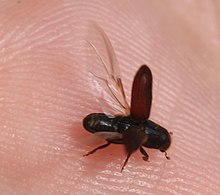Hylurgus ligniperda
| Hylurgus ligniperda | ||||||||||||
|---|---|---|---|---|---|---|---|---|---|---|---|---|

Hylurgus ligniperda |
||||||||||||
| Systematics | ||||||||||||
|
||||||||||||
| Scientific name | ||||||||||||
| Hylurgus ligniperda | ||||||||||||
| ( Fabricius , 1787) |
Hylurgus ligniperda is a representative of the bark beetle (Scolytinae).
features
The beetles are 5 to 5.7 millimeters long and have a slender cylindrical body. They are black-brown to red-brown in color and have dense hairs, especially on the wing cover . The stray hairs on the pronotum pages are much longer than those of the wing covers. The eyes are lateral, the antennae shaft is club-shaped, the antennae flagella 6-jointed, the antennae-lobe 3-jointed.
distribution
In addition to Hylurgus ligniperda, there is another species of the genus in Europe: Hylurgus miklitzi . The beetle species occurs throughout Europe. The species is found in the Canaries , Madeira , the Azores , North Africa, the Caucasus and Japan . The beetle species has also been transported to various places around the world. These include South Africa , St. Helena , Australia (Eastern Australia), New Zealand and South America (Uruguay, Chile). The species has also arrived in North America (first found in the US state of New York in 1994). The species is now also present in California.
Way of life
Hylurgus ligniperda lives mainly in the coarse-barked parts of Scots pine ( Pinus sylvestris ) and black pine ( Pinus nigra austriaca ). The Weymouth pine ( Pinus strobus ) is also counted among the host trees of the bark beetle species. The beetles prefer to live in felled trees and tree stumps. The adult beetles usually overwinter in groups in pine stumps. The one-armed mother passage is 10-15 cm long. The hatched larvae develop in the host trees. They go through four larval stages and finally pupate at the end of their larval duct. The beetles can cause damage in pine tree plantations and are therefore considered to be minor forest pests . However, their harmful effect is increased in combination with the ragweed fungi Leptographium truncatum and Leptographium procerum .
Taxonomy
The following synonyms can be found in the literature :
- Bostrichus ligniperda Fabricius , 1787
- Bostrichus elongatus autumn , 1793
- Hylurgus elongatus ( autumn , 1793)
- Bostrichus flavipes carapace , 1795
- Hylurgus flavipes ( carapace , 1795)
Individual evidence
- ↑ a b c d e Arved Lompe: Hylurgus determination table . coleonet.de. Retrieved April 17, 2020.
- ↑ a b c d e f New Introduction: The Red-haired Bark Beetle, Hylurgus ligniperda Fabricius (Coleoptera: Scolytidae) (PDF, 911 KB) Pest Alert, USDA Forest Service. Retrieved April 17, 2020.
- ↑ a b c Golden-haired Bark Beetle Hylurgis ligniperda . New Zealand Farm Forestry Association. Retrieved April 17, 2020.


